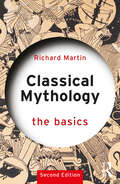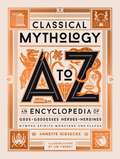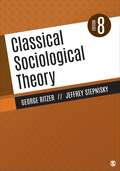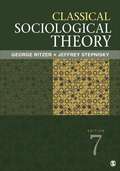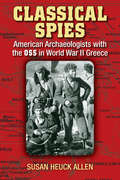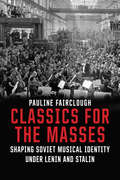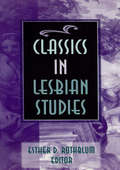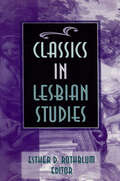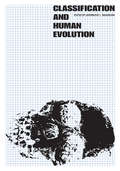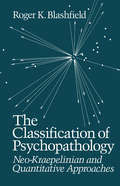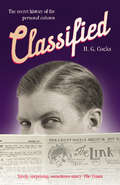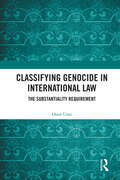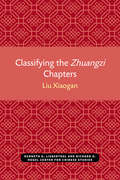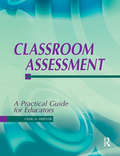- Table View
- List View
Classical Mythology
by Robert J. Lenardon Michael Sham Mark MorfordBuilding on the best-selling tradition of previous editions, Classical Mythology, Twelfth Edition, is the most comprehensive survey of classical mythology available--and the first full-color textbook of its kind. Featuring the authors' clear and extensive translations of original sources, it brings to life the myths and legends of Greece and Rome in a lucid and engaging style. The text contains a wide variety of faithfully translated passages from Greek and Latin sources, including Homer, Hesiod, all the Homeric Hymns, Pindar, Aeschylus, Sophocles, Euripides, Herodotus, Plato, Lucian, Lucretius, Vergil, Ovid, and Seneca. The acclaimed author team incorporates a dynamic combination of poetic narratives and enlightening commentary to make the myths come alive for students. Offering historical and cultural background, they also examine the enduring survival of classical mythology and its influence in the fields of art, literature, music, dance, and film.
Classical Mythology: The Basics (The Basics)
by Richard MartinThis new edition introduces the core elements of ancient Greek and Roman narratives about immortal gods and heroic humans. It explains how myths once shaped ancient ways of thinking, and how they have fascinated and inspired artists, writers, musicians, scientists, and scholars since. In six clear and concise chapters, this book explains what myths are, sketches the main stories about divinities, heroes and heroines, and explores through specific case studies the ways in which they influenced modern culture, from Renaissance opera to contemporary video games and social movements. The second edition also features a new chapter analyzing how myths have been used in politics from antiquity to the present day. More than two dozen illustrations, maps, and charts complement the text. No prior knowledge of mythology is assumed, and the book incorporates the latest scholarship on classical mythology, providing annotated lists of further readings. Anyone who has encountered Greek or Roman myths in literature, art, or pop culture and wants to know more about the cultural contexts for the stories will benefit from this compact book. Intended for a wide readership, the second edition of Classical Mythology: The Basics continues to off er a clear introduction to the subject for undergraduates, scholars, and the general reader.
Classical Mythology: The Basics (The Basics)
by Richard MartinThis new edition introduces the core elements of ancient Greek and Roman narratives about immortal gods and heroic humans. It explains how myths once shaped ancient ways of thinking, and how they have fascinated and inspired artists, writers, musicians, scientists, and scholars since. In six clear and concise chapters, this book explains what myths are, sketches the main stories about divinities, heroes and heroines, and explores through specific case studies the ways in which they influenced modern culture, from Renaissance opera to contemporary video games and social movements. The second edition also features a new chapter analyzing how myths have been used in politics from antiquity to the present day. More than two dozen illustrations, maps, and charts complement the text. No prior knowledge of mythology is assumed, and the book incorporates the latest scholarship on classical mythology, providing annotated lists of further readings. Anyone who has encountered Greek or Roman myths in literature, art, or pop culture and wants to know more about the cultural contexts for the stories will benefit from this compact book. Intended for a wide readership, the second edition of Classical Mythology: The Basics continues to off er a clear introduction to the subject for undergraduates, scholars, and the general reader.
Classical Mythology A to Z: An Encyclopedia of Gods & Goddesses, Heroes & Heroines, Nymphs, Spirits, Monsters, and Places
by Annette GieseckeAn encyclopedic A-to-Z guide, this beautifully illustrated volume offers hundreds of rich, fascinating definitions of 700 major and minor characters, creatures, and places of classical mythology. Classical Mythology A-to-Z is a comprehensive and engrossing guide to Greek and Roman mythology. Written by Annette Giesecke, PhD, Professor of Classics and Chair of Ancient Greek and Roman Studies at the University of Delaware, this brilliant reference offers clear explanations of every character and locale, and captures the essence of these timeless tales.From the gods and goddesses of Mount Olympus and the heroes of the Trojan War to the nymphs, monsters, and other mythical creatures that populate these ancient stories, Giesecke recounts, with clarity and energy, the details of more than 700 characters and places. Each definition includes cross-references to related characters, locations, and myths, as well their equivalent in Roman mythology and cult.In addition to being an important standalone work, Classical Mythology A-to-Z is also written, designed, and illustrated to serve as an essential companion to the bestselling illustrated 75th-anniversary edition of Mythology by Edith Hamilton, including 10 full-color plates and 2-color illustrations throughout by artist Jim Tierney.
Classical Projections: The Practice and Politics of Film Quotation
by Eleni PalisQuotations are a standard way that the humanities make meaning; the pull-quote, epigraph, and quotation are standard for citing evidence and invoking and interrogating authority in both literary and scholarly writing. However, film studies has yet to seriously examine how moving images can quote one another, convening interaction and creating new knowledge across time. Classical Projections offers "film quotation" as a new concept for understanding how preexisting moving image fragments are reframed and re-viewed within subsequent films. As a visual corollary to literary quotation, film quotations embed film fragments in on-screen movie screens. Though film quotations have appeared since silent cinema, Classical Projections focuses on quotations of classical Hollywood film--mainstream American studio production, 1915-1950--as quoted in post-classical Hollywood, roughly 1960 to present. This strategic historical frame asks: how does post-classical cinema visualize its awareness of coming after a classical or golden age? How do post-classical filmmakers claim or disavow classical history? How do historically disenfranchised post-classical filmmakers, whether by gender, sexuality, or race, grapple with exclusionary and stereotype-ridden canons? As a constitutive element of post-classical authorship, film quotations amass and manufacture classical Hollywood in retrospective, highly strategic ways. By revealing how quotational tellings of film history build and embolden exclusionary, myopic canons, Classical Projections uncovers opportunities to construct more capacious cultural memory.
Classical Projections: The Practice and Politics of Film Quotation
by Eleni PalisQuotations are a standard way that the humanities make meaning; the pull-quote, epigraph, and quotation are standard for citing evidence and invoking and interrogating authority in both literary and scholarly writing. However, film studies has yet to seriously examine how moving images can quote one another, convening interaction and creating new knowledge across time. Classical Projections offers "film quotation" as a new concept for understanding how preexisting moving image fragments are reframed and re-viewed within subsequent films. As a visual corollary to literary quotation, film quotations embed film fragments in on-screen movie screens. Though film quotations have appeared since silent cinema, Classical Projections focuses on quotations of classical Hollywood film--mainstream American studio production, 1915-1950--as quoted in post-classical Hollywood, roughly 1960 to present. This strategic historical frame asks: how does post-classical cinema visualize its awareness of coming after a classical or golden age? How do post-classical filmmakers claim or disavow classical history? How do historically disenfranchised post-classical filmmakers, whether by gender, sexuality, or race, grapple with exclusionary and stereotype-ridden canons? As a constitutive element of post-classical authorship, film quotations amass and manufacture classical Hollywood in retrospective, highly strategic ways. By revealing how quotational tellings of film history build and embolden exclusionary, myopic canons, Classical Projections uncovers opportunities to construct more capacious cultural memory.
Classical Sociological Theory (Seventh Edition) (PDF)
by George Ritzer Jeffrey StepniskyClassical Sociological Theory, Seventh Edition provides a comprehensive overview of the major theorists and schools of sociological thought from the Enlightenment roots of theory through the early 20th Century. The integration of key theories with biographical sketches of theorists and the requisite historical and intellectual context helps students to better understand the original works of classical authors as well as to compare and contrast classical theories.
Classical Spies: American Archaeologists with the OSS in World War II Greece
by Susan H Allen“Classical Spies will be a lasting contribution to the discipline and will stimulate further research. Susan Heuck Allen presents to a wide readership a topic of interest that is important and has been neglected.” —William M. Calder III, University of Illinois, Urbana-Champaign Classical Spies is the first insiders’ account of the operations of the American intelligence service in World War II Greece. Initiated by archaeologists in Greece and the eastern Mediterranean, the network drew on scholars’ personal contacts and knowledge of languages and terrain. While modern readers might think Indiana Jones is just a fantasy character, Classical Spies disclosesevents where even Indy would feel at home: burying Athenian dig records in an Egyptian tomb, activating prep-school connections to establish spies code-named Vulture and Chickadee, and organizing parachute drops. Susan Heuck Allen reveals remarkable details about a remarkable group of individuals. Often mistaken for mild-mannered professors and scholars, such archaeologists as University of Pennsylvania’s Rodney Young, Cincinnati’s Jack Caskey and Carl Blegen, Yale’s Jerry Sperling and Dorothy Cox, and Bryn Mawr’s Virginia Grace proved their mettle as effective spies in an intriguing game of cat and mouse with their Nazi counterparts. Relying on interviews with individuals sharing their stories for the first time, previously unpublished secret documents, private diaries and letters, and personal photographs, Classical Spies offers an exciting and personal perspective on the history of World War II.
Classics for the Masses: Shaping Soviet Musical Identity under Lenin and Stalin
by Pauline FaircloughMusicologist Pauline Fairclough explores the evolving role of music in shaping the cultural identity of the Soviet Union in a revelatory work that counters certain hitherto accepted views of an unbending, unchanging state policy of repression, censorship, and dissonance that existed in all areas of Soviet artistic endeavor. Newly opened archives from the Leninist and Stalinist eras have shed new light on Soviet concert life, demonstrating how the music of the past was used to help mold and deliver cultural policy, how “undesirable” repertoire was weeded out during the 1920s, and how Russian and non-Russian composers such as Mozart, Tchaikovsky, Wagner, Bach, and Rachmaninov were “canonized” during different, distinct periods in Stalinist culture. Fairclough’s fascinating study of the ever-shifting Soviet musical-political landscape identifies 1937 as the start of a cultural Cold War, rather than occurring post-World War Two, as is often maintained, while documenting the efforts of musicians and bureaucrats during this period to keep musical channels open between Russia and the West.
Classics in Film and Fiction (Film/Fiction)
by Deborah Cartmell I. Q. Hunter Heidi Kaye Imelda WhelehanThis book negotiates the notion of a 'classic' in film and fiction, exploring the growing interface and the blurring of boundaries between literature and film. Taking the problematic term 'classic' as its focus, the contributors consider both canonical literary and film texts, questioning whether classic status in one domain transfers it to another.*BR**BR*Classics in Film and Fiction looks at a wide range of texts and their adaptations. Authors discussed are Shakespeare, Charlotte Bronte, Henry James, Franz Kafka, Thomas Mann, Virginia Woolf, Nathaniel Hawthorne, Arthur Miller, Truman Capote and Lewis Carroll. Book to film adaptations analysed include Jane Eyre, The Crucible, The Tempest and Alice in Wonderland. The collection also evaluates the term 'classic' in a wider context, including a comparison of Joyce's Ulysses with Hitchcock's Rear Window. Throughout, the contributors challenge the dichotomy between high culture and pop culture.
Classics in Lesbian Studies
by Esther D RothblumClassics in Lesbian Studies takes a major step in giving the lesbian experience its own unique voice within scholarship and the larger world society. Thus, it is devoted exclusively to the lesbian experience and serves as a vehicle for the promotion of scholarship and commentary on lesbianism from an international perspective. Not only does it ensure that “classic” pieces are not forgotten by new generations of students and scholars, it also spurs further lesbian research, writing, theory, and scholarship.In Classics in Lesbian Studies, you are introduced to descriptive, theoretical, empirical, applied, and multicultural perspectives in the field of lesbian studies. Interdisciplinary, the book presents pieces from various academic areas in multiple formats, including personal accounts, poetry, editorials, debates, and commentaries. For your convenience, the chapters are organized primarily across four categories: identity, history and literature, physical and social sciences, and “back to lesbian politics.” You will find the discussions of the following issues and subjects provocative and insightful: ways black women in the diaspora construct and name their sexual and romantic feelings for other women lesbian identity formation in a changing social environment how lesbians maneuver in the dominant culture and their own subculture lesbianism as a political movement the experiences of lesbian adolescents teaching lesbian studies lesbians and societal institutions, including the work place, the media, the political arena, the legal system, and religion using lesbian-feminist scholarship to reexamine women's lives in the pastStudents, scholars, lesbian feminists, and others interested in lesbian studies will find Classics in Lesbian Studies a vital examination of lesbianism since its grass roots. Not only does it consider the progress made since the initial days of fighting for liberation, it also explores a more distant, repressed past and anticipates future possibilities lying before us. This powerful, insightful collection is sure to become a classic as it grapples with virtually all aspects of lesbianism, from its inception as a political movement to its identity as a lifestyle choice to its implications of community.
Classics in Lesbian Studies
by Esther D RothblumClassics in Lesbian Studies takes a major step in giving the lesbian experience its own unique voice within scholarship and the larger world society. Thus, it is devoted exclusively to the lesbian experience and serves as a vehicle for the promotion of scholarship and commentary on lesbianism from an international perspective. Not only does it ensure that “classic” pieces are not forgotten by new generations of students and scholars, it also spurs further lesbian research, writing, theory, and scholarship.In Classics in Lesbian Studies, you are introduced to descriptive, theoretical, empirical, applied, and multicultural perspectives in the field of lesbian studies. Interdisciplinary, the book presents pieces from various academic areas in multiple formats, including personal accounts, poetry, editorials, debates, and commentaries. For your convenience, the chapters are organized primarily across four categories: identity, history and literature, physical and social sciences, and “back to lesbian politics.” You will find the discussions of the following issues and subjects provocative and insightful: ways black women in the diaspora construct and name their sexual and romantic feelings for other women lesbian identity formation in a changing social environment how lesbians maneuver in the dominant culture and their own subculture lesbianism as a political movement the experiences of lesbian adolescents teaching lesbian studies lesbians and societal institutions, including the work place, the media, the political arena, the legal system, and religion using lesbian-feminist scholarship to reexamine women's lives in the pastStudents, scholars, lesbian feminists, and others interested in lesbian studies will find Classics in Lesbian Studies a vital examination of lesbianism since its grass roots. Not only does it consider the progress made since the initial days of fighting for liberation, it also explores a more distant, repressed past and anticipates future possibilities lying before us. This powerful, insightful collection is sure to become a classic as it grapples with virtually all aspects of lesbianism, from its inception as a political movement to its identity as a lifestyle choice to its implications of community.
Classics in Media Theory
by Fredrik Stiernstedt Stina Bengtsson Staffan EricsonThis comprehensive collection introduces and contextualizes media studies’ most influential texts and thinkers, from early 20th century mass communication to the first stages of digital culture in the 21st century.The volume brings together influential theories about media, mediation and communication, as well as the relationships between media, culture and society. Each chapter presents a close reading of a classic text, written by a contemporary media studies scholar. Each contributor presents a summary of this text, relates it to the traditions of ideas in media studies and highlights its contemporary relevance. The text explores the core theoretical traditions of media studies: in particular, cultural studies, mass communication research, medium theory and critical theory, helping students gain a better understanding of how media studies has developed under shifting historical conditions and giving them the tools to analyse their contemporary situation.This is essential reading for students of media and communication and adjacent fields such as journalism studies, sociology and cultural studies.
Classics in Media Theory
This comprehensive collection introduces and contextualizes media studies’ most influential texts and thinkers, from early 20th century mass communication to the first stages of digital culture in the 21st century.The volume brings together influential theories about media, mediation and communication, as well as the relationships between media, culture and society. Each chapter presents a close reading of a classic text, written by a contemporary media studies scholar. Each contributor presents a summary of this text, relates it to the traditions of ideas in media studies and highlights its contemporary relevance. The text explores the core theoretical traditions of media studies: in particular, cultural studies, mass communication research, medium theory and critical theory, helping students gain a better understanding of how media studies has developed under shifting historical conditions and giving them the tools to analyse their contemporary situation.This is essential reading for students of media and communication and adjacent fields such as journalism studies, sociology and cultural studies.
Classification and Human Evolution
by Sherwood L. WashburnThe names given to the variety of man-like fossils known to scientists should reflect no more than scientific views of the nature of human evolution. However, often in the past these names have also reflected confusion regarding the basic principles of scientific nomenclature; and the matter has been further complicated by the many new finds of recent decades. It is the unique purpose of this book to clarify the present state of knowledge regarding the main lines of human evolution by expressing what is known (and what is surmised) about them in appropriate taxonomic language.The papers in this volume were prepared by the world's leading authorities on the subject, and were revised in the light of discussions at a remarkable conference held in Austria in 1962 under the auspices of the Wenner-Gren Foundation. The authors review first the meaning of taxonomic statements as such, and then consider the substance of our present knowledge regarding the number and characteristics of species among living and extinct primates, including man and his ancestors. They also examine the relationship of behavior changes and selection pressures in evolutionary sequences.Ample illustrations, bibliographies and an index enhance the permanent reference value of the book, which will undoubtedly prove to be among the fundamental paleoanthropological works of our time.
Classification and Human Evolution
by Sherwood L. WashburnThe names given to the variety of man-like fossils known to scientists should reflect no more than scientific views of the nature of human evolution. However, often in the past these names have also reflected confusion regarding the basic principles of scientific nomenclature; and the matter has been further complicated by the many new finds of recent decades. It is the unique purpose of this book to clarify the present state of knowledge regarding the main lines of human evolution by expressing what is known (and what is surmised) about them in appropriate taxonomic language.The papers in this volume were prepared by the world's leading authorities on the subject, and were revised in the light of discussions at a remarkable conference held in Austria in 1962 under the auspices of the Wenner-Gren Foundation. The authors review first the meaning of taxonomic statements as such, and then consider the substance of our present knowledge regarding the number and characteristics of species among living and extinct primates, including man and his ancestors. They also examine the relationship of behavior changes and selection pressures in evolutionary sequences.Ample illustrations, bibliographies and an index enhance the permanent reference value of the book, which will undoubtedly prove to be among the fundamental paleoanthropological works of our time.
The Classification of Psychopathology: Neo-Kraepelinian and Quantitative Approaches
by R. K BlashfieldClassified: The Secret History of the Personal Column
by H G Cocks'Lonely Young Officer, up to his neck in Flanders mud, would like to correspond with young lady (age 18-20), cheery and good looking.' 1916'Discreet, attractive couple 21 and 25 wish to meet couples and singles 21-35 for exciting and fun-loving adult relationships. Open-minded but not way out. No prejudices. Full length photo, address, and detailed letter assures same.' 1969From the 'sporty' girls and 'artistic' boys of the Edwardian era to the 'lonely' soldiers of the Great War, the marriage bureaux of the fifties, and on to the internet dating sites of today, Classified tells the story of those who used personal ads to search for love, friendship, marriage and adventure.
Classifying Genocide in International Law: The Substantiality Requirement
by Onur UrazThis book offers an in-depth examination into genocide law by focusing on one of the lesser examined, yet practically significant, issues: the ‘substantiality requirement’. This refers to the requirement in international law that intended destruction should be directed towards a ‘substantial’ part of a protected group in order for an atrocity to qualify as genocide. This comprehensive and detailed study draws connections between different judicial approaches to ‘substantiality’ and the varying theoretical presumptions about the constitutive concepts of the crime. This prima facia doctrinal problem is used as a springboard to scrutinise the broader theoretical problems underlying the legal conceptualisation of genocide. The book systematically explores how the individualistic and collectivistic conceptions of the crime have been able to co-exist in case law and how the different approaches to assessing substantiality have played a backdoor role between these two conceptions. The work demonstrates that these two philosophical standpoints are far from effectively representing the reality of the protected groups and fully explaining the harm inherent to group destruction. The book revisits the recent philosophical and sociological studies on the crime and, considering ideas from the emerging ‘relational approaches to genocide’, offers a third way to understand the existing legal representation of the crime and, consequently, the idea of ‘substantiality’. It demonstrates the practical significance of its theoretical debates and applies its novel perspective through a case study on South Sudan. This book will be highly useful to students and scholars with an interest in genocide studies, international criminal law and legal theory. It will also be of interest to policymakers engaged with issues around genocide.
Classifying Genocide in International Law: The Substantiality Requirement
by Onur UrazThis book offers an in-depth examination into genocide law by focusing on one of the lesser examined, yet practically significant, issues: the ‘substantiality requirement’. This refers to the requirement in international law that intended destruction should be directed towards a ‘substantial’ part of a protected group in order for an atrocity to qualify as genocide. This comprehensive and detailed study draws connections between different judicial approaches to ‘substantiality’ and the varying theoretical presumptions about the constitutive concepts of the crime. This prima facia doctrinal problem is used as a springboard to scrutinise the broader theoretical problems underlying the legal conceptualisation of genocide. The book systematically explores how the individualistic and collectivistic conceptions of the crime have been able to co-exist in case law and how the different approaches to assessing substantiality have played a backdoor role between these two conceptions. The work demonstrates that these two philosophical standpoints are far from effectively representing the reality of the protected groups and fully explaining the harm inherent to group destruction. The book revisits the recent philosophical and sociological studies on the crime and, considering ideas from the emerging ‘relational approaches to genocide’, offers a third way to understand the existing legal representation of the crime and, consequently, the idea of ‘substantiality’. It demonstrates the practical significance of its theoretical debates and applies its novel perspective through a case study on South Sudan. This book will be highly useful to students and scholars with an interest in genocide studies, international criminal law and legal theory. It will also be of interest to policymakers engaged with issues around genocide.
Classifying Science: Phenomena, Data, Theory, Method, Practice (Information Science and Knowledge Management #7)
by Rick SzostakClassification is the essential first step in science. The study of science, as well as the practice of science, will thus benefit from a detailed classification of different types of science. In this book, science - defined broadly to include the social sciences and humanities - is first unpacked into its constituent elements: the phenomena studied, the data used, the theories employed, the methods applied, and the practices of scientists. These five elements are then classified in turn. Notably, the classifications of both theory types and methods allow the key strengths and weaknesses of different theories and methods to be readily discerned and compared. Connections across classifications are explored: should certain theories or phenomena be investigated only with certain methods? What is the proper function and form of scientific paradigms? Are certain common errors and biases in scientific practice associated with particular phenomena, data, theories, or methods? The classifications point to several ways of improving both specialized and interdisciplinary research and teaching, and especially of enhancing communication across communities of scholars. The classifications also support a superior system of document classification that would allow searches by theory and method used as well as causal links investigated.
Classifying the Zhuangzi Chapters (Michigan Monographs In Chinese Studies #65)
by Xiaogan LiuThe relationships, both historical and philosophical, among the Zhuangzi’s Inner, Outer, and Miscellaneous chapters are the subject of ancient and enduring controversy. Liu marshals linguistic, intertextual, intratextual, and historical evidence to establish an objectively demonstrable chronology and determine the philosophical affiliations among the various chapters. This major advance in Zhuangzi scholarship furnishes indispensable data for all students of the great Daoist text. In a lengthy afterword, Liu compares his conclusions with those of A. C. Graham and addresses the relationship between the Zhuangzi and the Laozi.
Classroom Assessment: A Practical Guide for Educators
by Dr Craig Mertler• Provides detailed information on· the functions of assessment;· how to construct, administer, and interpret the results of teacher-developed assessment techniques; and· how to interpret the results of externally developed instruments such as standardized tests.• Both traditional and newer, alternative assessment techniques are covered.• Advantages and disadvantages of each assessment technique are discussed.• A companion website helps both instructors and students obtain additional information on topics of special interest to them.• Numerous examples of the principles and procedures make it easy for students to understand the material.• The highly practical nature of this book stems from the focus on how assessment intertwines with other everyday activities in classrooms.• Measurement theory and computational procedures that are unlikely to be used by classroom teachers are de-emphasized, producing a textbook that provides comprehensive coverage without being unnecessarily technical.
Classroom Assessment: A Practical Guide for Educators
by Dr Craig Mertler• Provides detailed information on· the functions of assessment;· how to construct, administer, and interpret the results of teacher-developed assessment techniques; and· how to interpret the results of externally developed instruments such as standardized tests.• Both traditional and newer, alternative assessment techniques are covered.• Advantages and disadvantages of each assessment technique are discussed.• A companion website helps both instructors and students obtain additional information on topics of special interest to them.• Numerous examples of the principles and procedures make it easy for students to understand the material.• The highly practical nature of this book stems from the focus on how assessment intertwines with other everyday activities in classrooms.• Measurement theory and computational procedures that are unlikely to be used by classroom teachers are de-emphasized, producing a textbook that provides comprehensive coverage without being unnecessarily technical.

